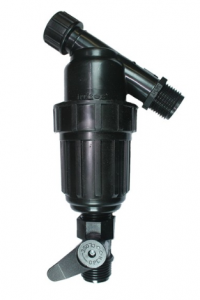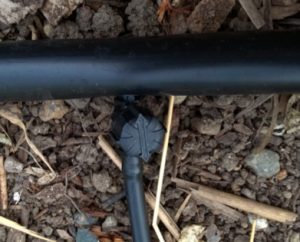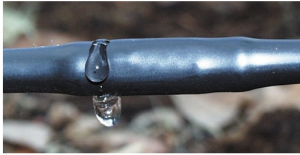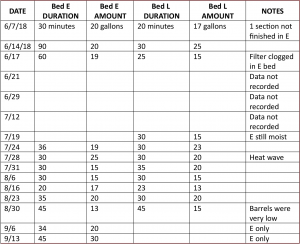Trial 2: “E” Bed
TRIAL 2: Kale & Cabbage/Summer Squash/Collards/Chard and Beets
Installed 06/02/20181/4″ soaker dripline with preinstalled emitters 6″ apart and Y-type filter with 200 mesh screen (DripWorks)
PROS: Inexpensive, easy to set up, even water distribution, can customize to turn zones off or on
CONS: Keep lines short (18 feet max for 6″ emitters)
For our second trial, we chose a raised garden bed that is configured in the shape of an uppercase letter E. The back end of the bed (the “spine” of the E) runs parallel to the freeway sound wall. The water barrel is secured to a tower that is elevated 5 feet above the bed next to the wall. We attached a “Y” type filter to the base of the water barrel and connected the other end to a piece of garden hose that is long enough to reach the bed. The filter can be taken apart and cleaned at any time. Due to algae growth, we chose to clean it every time we filled the barrel.
The hose is attached to a 20-foot long line of solid ½-inch polyethylene main line tubing with a cam level coupling. The mainline lies on top of soil inside the bed parallel to the “spine” of the E. We closed off ends of the line with ½” Easy Loc End Caps that can be opened and flushed if the line becomes clogged. One of our gardeners had used compression fittings in the past and wanted to see if Easy Loc fittings would be easier to work with. She reports that they were. Easy Loc and compression fittings are not necessarily interchangeable, so it is wise to decide what type you want to use before you start purchasing parts.
The bed is divided into sections. Three sections are 7.5 feet long by 4 feet wide; 2 sections are 3.5 feet long by 4 feet wide. We attached ¼-inch soaker drip lines to the mainline tubing approximately every 9 inches apart. Each section has 4 drip lines. The drip lines contain preinstalled emitters spaced every 6 inches apart. Each drip line is attached to the mainline with a barbed ¼” Micro-Flow valve. This allows us to shut off individual lines in the bed if required. This is useful when nothing is growing along a drip line or when cultivating crops that no longer need to be watered when close to harvest time, such as garlic and tomatoes.
Gray line: hose that connects to elevated water barrel
Black line: ½” polyethylene mainline tubing
Blue lines: ¼” soaker drip lines
NOTE: 3 sections are shown. Bed contains 5 sections.
We began installing the system for Trial 2 on July 2. Installation was fairly simple but took more time than it did for Trial 1. We miscalculated the amount of drip line required so we had to order more drip line and finished putting it together on July 12.
All of the drip irrigation equipment for beds E and L were ordered from DripWorks. Many companies carry similar products at comparable prices. DripWorks has a good reputation and carries a few products that other companies do not. Irrigation lines can be laid out in a variety of ways and there are many designs available in print and on the Internet. DripWorks offers gravity-fed irrigation designs as well as resources on their websites for both pressurized and gravity-fed systems.
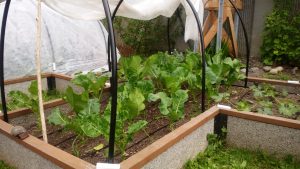
We estimated that the plants in the E and L beds would need 15 to 20 gallons of water per week depending on the weather. We based this on how much water we used growing similar crops and watering by hand for the previous two years. We also pulled up small samples of soil using a corer and felt for moisture content before watering. When the beds were built 3 years ago, logs were buried in the soil that may further aid water retention. Compost was added last spring at planting time.
We set up a chart to keep track of when we watered, how long it took and how many gallons were used. We recorded when we watered in June, but failed to record the duration and amount used. From July onward, we got better at keeping track. Another problem was that the ink we used to record faded in the light making it difficult to read what we had written.
Bed E: Partially finished on 6/2/2018 and completed on 6/14/2018.
Bed L: Installation completed on 6/19/2018. Stopped watering on 8/30/2018.
None of the emitters stopped working, but the rate of flow varied depending on how much water was in the barrel and if the filter had been cleaned before refilling the barrel. If the barrel was full and the filter was clean, it usually took 20 to 30 minutes to irrigate the bed with 20 gallons of water. It took longer if there was less than 20 gallons in the barrel and the filter had not been cleaned. We learned that it was a good idea to clean the filter each time before refilling the barrels with the treadle pump.
Drip lines are adequate for transplants but may not disperse water far enough to germinate newly sown seeds if they are not planted right next to the lines. We found that we needed to do extra watering by hand in between periods when we ran the system if we wanted to germinate seeds because the top inch of soil dried out too quickly. In pressurized systems micro-sprayers are often attached to ¼-inch drip lines for this purpose, but we did not try doing this. We do not know if there is enough pressure to use micro-sprayers with a gravity-fed system. Manufacturers do not recommend using them with such systems.
Seattle experienced a record dry period in 2018, starting in May. The Seattle area got less rain than average in May and June. In May we received .12 inches compared to the monthly average of 1.94 inches; in June, .63 inches compared to 1.57 inches of rain (Seattle Weather Blog and King 5 news). It was also warmer than normal.
High temperatures and pests appeared to have more of a negative impact on crop yield than how much water the plants received. The sections that were planted with collards, kale and chard/beets were covered with floating row cover (Reemay), but pests still managed to get in. The floating row cover raised the temperature in these beds but may have also helped retain some humidity. The squash plants were not covered and were mulched with straw. Squash production slowed when the temperatures went into the 90s but resumed when it cooled down enough for pollinators to fly.
None of the plants in the E bed sections wilted, flagged or showed other more obvious signs of insufficient water. However, the kale grew more slowly and the leaves were smaller during and after the heat wave in July. The collards and chard leaves continued to grow to expected size, but half of the collard plants bolted (flowered), which could have been due to the heat. The beets also stayed small. We had amended the soil with organic nitrogen fertilizers in spring and the plants did not show signs of nutrient deficiencies but beets require higher levels of boron, which might have been low.

